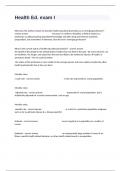Health Ed. exam I
Why have the authors chosen to describe health education/promotion as an emerging profession? -
correct answer -because it is neither a discipline (a field of study) or a
profession (a calling requiring specialized knowledge and often long and intensive academic
preparation), but somewhere in between, thus the term "emerging profession"
What is the current status of health education/promotion? - correct answer -
the health of the people in the United States is better than any time in the past. "By every measure, we
are healthier, live longer, and enjoy lives that are less likely to be marked by injuries, ill health, or
premature death." Yet we could do better
-the status of the profession is more visible to the average person and more widely accepted by other
health professionals than it has ever been
Morality rates
-crude rate - correct answer -is the rate expressed for a total population.
Morality rates
-adjusted rate - correct answer -expressed for a total population, but is
statistically adjusted for a certain characteristic, such as age.
Morality rates
-specific rate - correct answer -is a rate for a particular population subgroup
such as for a particular disease (i.e. disease-specific)
Endemic - correct answer -occurs regularly in a population as a matter of
course
Epidemic - correct answer -an unexpectedly large number of cases of an
illness, specific health related behavior, or other health related event in a population
,Pandemic - correct answer -an outbreak over a wide geographical area, such as
a continent.
Life expectancy - correct answer -the average number of years of life
remaining to a person at a particular age and is based on a given set of age-specific death rates,
generally the mortality conditions existing in the period mentioned.
-may be determined by race, sex, or other characteristics using age specific death rates for the
population with that characteristic
Years of Potential Life Lost (YPLL) - correct answer -a measure of premature
mortality
-it is calculated by subtracting a persons age at death from seventy-five years
-for example, for a person who dies at age 30, the YPLL is 45
Disability-Adjusted Life Years (DALYs) - correct answer -because mortality does
not express the burden of living with disability (for example, the resulting paralysis from an automobile
crash or the depression that often follows a stroke), the WHO and the World Bank developed a measure
called DALYS. One DALY can be thought of as one lost year of "healthy" life due to being in states of poor
health or disability.
-For example, to calculate DALYs incurred through road accidents in India in 1990, add the total years of
life lost in fatal road accidents and the total years of life lived with disabilities by survivors of such
accidents.
Health Adjusted Life Expectancy (HALE) - correct answer -based on disability
and life expectancy rather than mortality
-is the number of years of healthy life expected, on average, in a given population.
-can be calculated at birth and at other ages
Health Related Quality of Life (HRQOL) - correct answer -refers to a person or a
groups perceived physical and mental health over time
-health care providers often use this to measure the effects of chronic disease in their patients to better
understand how a disease interferes with a persons daily life.
-public health professionals use this to measure the effects of numerous disorders, short-and long-term
disabilities and diseases in different populations
, National Health Interview Survey (NHIS) - correct answer -a telephone
interview in which respondents are asked a number of questions about their health and health behavior.
-has been used for over 50 years
-one of the questions for example, asks the respondents to describe their health status using one of five
categories: excellent, very good, good, fair, or poor.
National Health and Nutrition Examination Survey (NHANES) - correct answer -
data is collected using a mobile examination center. Through direct physical examinations, clinical and
laboratory testing, and related procedures, data is collected on a representative group of americans.
-these exams result in the most authoritative source of standardized clinical, physical, and physiological
data on the U.S. population
National Health Care Surveys (NHCS) - correct answer -this group of surveys
was comprised of 6 different surveys that are designed to answer key questions about health care
providers
Behavioral Risk Factor Surveillance System (BRFSS) - correct answer -these
data are collected by individual states, territories, and the district of Columbia through cooperative
agreements with the centers for disease control prevention (CDC)
-through the use of telephone survey techniques, each state selects a probability sample from the
civilian, non-institutionalized adult population. Those selected are asked a set of standard core
questions, developed by the CDC in order to produce data about health behaviors that can be compared
across states.
Youth Risk Behavior Surveillance System (YRBSS)
-6 categories of priority health-risk behaviors: - correct answer -developed in
1990 to monitor priority health risk behaviors that contribute markedly to the leading causes of death,
disability, and social problems among youth and adults in the United States.
-tobacco use; unhealthy dietary behaviors; physical inactivity; alcohol and other drug use; sexual
behaviors that contribute to unintended pregnancy and std's; behaviors that contribute to unintentional
injuries and violence




